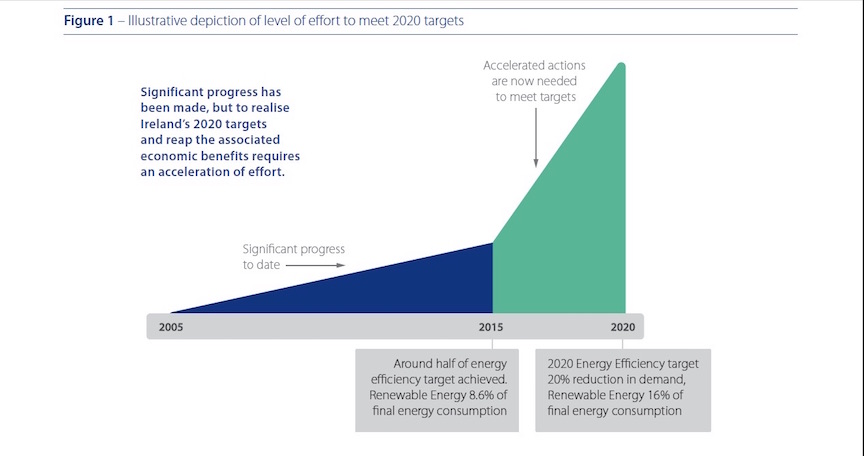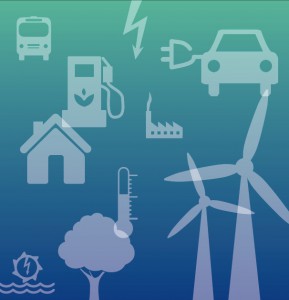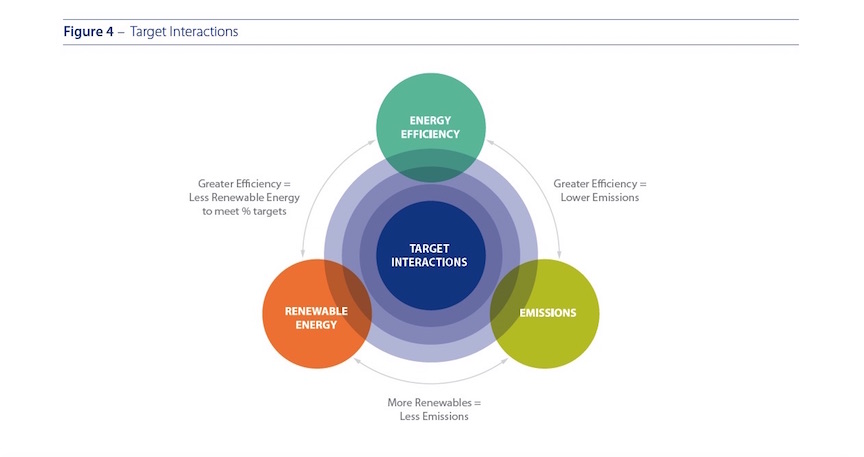Context
Last month we looked at an EPA report on the Irish government’s continuing failures to meet its greenhouse gas (GHG) emission obligations, in large part because of its unquestioning support for the agriculture sector. Now we see that the government is also failing its obligations for energy efficiency and renewable targets.
In describing a recent report by the Sustainable Energy Authority of Ireland (SEAI) on Ireland’s Energy Targets: Progress, Ambition & Impacts, the Friends of the Earth Ireland headlined its comments: “SEAI report shows politicians are sleepwalking into massive fines for missing our energy targets.” One of the advantages of sleepwalking is that you can claim total innocence for whatever havoc you wreaked on your walk. For instance, the government can claim that it was simply trying to catch up on its sleep (probably exhausted from the latest election), when, lo and behold, it woke up and discovered that while it was sleepwalking its EU obligations on energy had arrived and it had done almost nothing about it, and global warming had gotten much worse, unfortunately for the people of Ireland – you know, those pesky extreme weather events.
The SEAI has undertaken some impressive actions and programs, and produced many useful and sensible reports on sustainable energy. So it can be forgiven for its optimism when it offers a positive view of progress to date: “Meeting 2020 renewable energy and energy efficiency targets puts Ireland on a low carbon pathway towards meeting future targets.” At 3. Translated, this means: “Not meeting the 2020 energy targets puts Ireland on a steep downhill slide to non-compliance for future targets.” The SEAI report itself shows we are on a downhill slide, and that while SEAI has done what it can, the government has not.
Energy Efficiency
Absent a binding EU target, Ireland has committed to reducing energy demand by 20% of the historic average energy use during the period 2000-2005 through energy efficiency measures. Of course, this target could be met by simply reducing demand by, for instance, turning off lights, turning down heat, driving much less, and other sacrifices. But the policy choice has been to rely on efficient use of energy to give us the same level of comfort, or life style.
What are we doing, and how are we doing?
Energy efficiency is the easy way forward for reducing energy demand. The means of being efficient are well known, and depend on long-established methodologies and technologies. For example, governments can require more and more efficient products, from refrigerators to air conditioners to cars; and, require insulation for homes and schools and businesses.
Insulating new construction can be handled through better building regulations, which typically do not create a substantial add-on cost; efficient products can also be improved prospectively through regulations. The nagging issue is how much it will cost to insulate and buy efficient products, and to what extent the government will aid in the financing of these improvements.
So far Ireland is about 50% on the way to the target for energy efficiency savings as a result of measures that have been installed or adopted in 300,000 homes, 3,500 businesses and public sector bodies. These actions have resulted in savings of €700 million annually. These advances measure the 10-year period, 2005 to 2015.
However, to reach its 2020 target, less than 5 years away, the government needs to upgrade the energy efficiency of 75,000 home and businesses every year between now and 2020, or about 375,000 buildings in about 4-5 years. Grant schemes in 2014 supported energy efficiency in some 25,000 homes or businesses. That’s a shortfall of about 50,000 buildings each year. Then by 2030 and 2050, with new, more demanding targets from the EU, Ireland will fall far behind in its obligations.
 In addition, to meet the target, energy efficiency improvements will be needed in vehicles, large industry, the public sector, and in small and medium enterprises (SME). There is little indication of how this is going to happen.
In addition, to meet the target, energy efficiency improvements will be needed in vehicles, large industry, the public sector, and in small and medium enterprises (SME). There is little indication of how this is going to happen.
Renewable Energy
Ireland is also subject to a binding EU target for renewable energy use: 16% of final energy use and 10% of energy use in the transport sector must be derived from renewable energy by 2020. Ireland has set sub-targets of heat (12%) and electricity (40%) for its overall renewable energy target.
Again, what are we doing, how are we doing?
Unlike energy efficiency, generating more renewable energy, and in Ireland the predominate form is onshore wind, is not so simple. It does require installing energy infrastructure, including a smarter and more extensive energy grid. In other countries these have not been insurmountable obstacles. Unfortunately, in Ireland they have recently become quite contentious, in part because of the expansive growth in wind turbines across the landscape, and because of the unfortunate handling by the government of a massive wind project in the midlands, in conjunction with the United Kingdom government.
As with energy demand, Ireland is 50% on its way to meeting the 2020 target for renewable energy, with 8.6% final consumption derived from renewables in 2014. About 190 wind farms have been installed, in 24 counties, generating the equivalent of 2,375 MW of electricity. About 5.2% of the 10% target for renewable energy in the transport sector has been reached, from mixing 167 million litres of biofuels with petrol and diesel fuels. And about 40,000 homes and 550 businesses use some form of renewable energy for heat, which by 2014 constitutes 6.6% of the 12% sub-target.
As with energy efficiency, 50% sounds positive, but then we realize that we have only 4-5 years to achieve another 50% of the target. That means that in comparison to the installing of 270 MW of wind capacity in 2014, and an average of installed capacity of 177 MW over the past 5 years, we will need between 200 and 250 MW of additional wind capacity installed every year through 2020. Once again, we have little notion of what the government will do to make that happen, especially with the recent growth in opposition to wind turbines and electric grid pylons.
Besides the wind energy boosts, the government will need to supply 440 to 500 million litres of biofuels (only 167 million were used in 2014); assure that by 2020 sales of electric cars account for 20% of all car sales (they were 0.23% of sales in 2015); and, “encourage” 300,000 homes or 3,000 services/public sector or 200 large industrial sites to install renewable heat options (biomass boilers, solar thermal or biomass CHP systems), in comparison to 40,000 homes and 550 businesses in total by 2014.
It remains anybody’s guess how this will happen, but promoting cooperative or community ownership of wind farms would likely provide considerable assistance.
Going Forward, or Backward
Energy efficiency and renewable targets are intertwined. The more that we are efficient in the ways we use energy (e.g., driving the most efficient cars, or insulating our houses), then the less energy, including even less renewable energy, has to be generated. Conversely, the more renewable energy (e.g., wind power) we generate, the less efficient we have to be in using that energy in order to save on GHG emissions. Energy policy simply tries to balance how much energy we use and how much is renewable, all for the sake of lower GHG emissions and lower global warming.
To try to encourage the government to do what it has failed to do, SEAI sets down the economic benefits of meeting the targets Ireland has already promised to meet. So far € 700 million per year has been saved in reduced energy bills through improved energy efficiency and savings of €2.4 billion per year are possible. In addition, the actions to date have saved about 2.8 million tones of CO2. Finally, there are a host of non-financial benefits from energy efficiency, including better health, better air, energy security, lower energy prices, and poverty reduction, as outlined by the International Energy Agency (IEA).
If the financial carrots are not enough, SEAI adds a bitter pill: failure to meet the 2020 renewable energy targets will cost Ireland somewhere between €65 million and €130 million for each percentage shortfall in the targets. Miss the target by 5% and pay between €325 million and €650 million in fines to the EU.
As we have pointed out, there are not a lot of mysteries in how to meet the targets, just a lack of political resolve and commitment of resources.
Conclusion
The contribution of SEAI has been to show us where we are and how far we have to go. It is up to the government to actually implement a sustainable energy policy that will get us to 2020 meeting the required targets and to set us on a course to meet the even more stringent targets coming in 2030 and 2050. We can be forgiven if we remain skeptical.
If the government of Ireland cannot reduce fossil fuel energy usage or GHG emissions, then the people of Ireland will suffer for such profligacy, by paying for the EU fines and by destroying the environment they will leave their children and grandchildren.
Sources
SEAI, Ireland’s Energy Targets: Progress, Ambition & Impacts (April 2016). www.seai.ie/Publications/Statistics_Publications/Energy_Modelling_Group_Publications/Ireland’s-Energy-Targets-Progress-Ambition-and-Impacts.pdf
“The Irish Government Is Failing to Meet Its EU GHG Obligations, says an Irish EPA Report: A Look at the Message and the Messenger,” in the Reports section of irish environment magazine (April 2016). www.irishenvironment.com
Friends of the Earth Ireland press release , “SEAI report shows political will is missing ingredient. Politicians are sleepwalking us into massive fines, missing massive opportunities.” (6 April 2016). www.foe.ie/news/2016/04/06/seai-report-shows-political-will-is-missing-ingredient-politicians-are-sleepwalking-us-into-massive-fines-missing-massive-opportunities/




No comments yet, add your own below